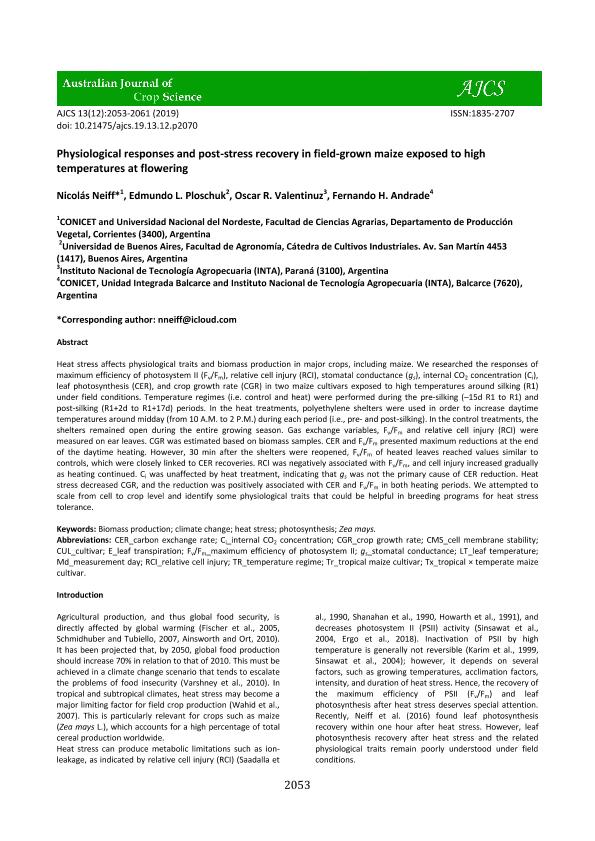Mostrar el registro sencillo del ítem
dc.contributor.author
Neiff, Nicolás

dc.contributor.author
Ploschuk, Edmundo Leonardo

dc.contributor.author
Valentinuz, Oscar Rodolfo

dc.contributor.author
Andrade, Fernando Héctor

dc.date.available
2023-01-04T14:32:55Z
dc.date.issued
2019-12
dc.identifier.citation
Neiff, Nicolás; Ploschuk, Edmundo Leonardo; Valentinuz, Oscar Rodolfo; Andrade, Fernando Héctor; Physiological responses and post-stress recovery in field-grown maize exposed to high temperatures at flowering; Southern Cross Publishing; Australian Journal of Crop Science; 13; 12; 12-2019; 2053-2061
dc.identifier.issn
1835-2693
dc.identifier.uri
http://hdl.handle.net/11336/183309
dc.description.abstract
Heat stress affects physiological traits and biomass production in major crops, including maize. We researched the responses of maximum efficiency of photosystem II (Fv/Fm), relative cell injury (RCI), stomatal conductance (gs), internal CO2 concentration (Ci), leaf photosynthesis (CER), and crop growth rate (CGR) in two maize cultivars exposed to high temperatures around silking (R1) under field conditions. Temperature regimes (i.e. control and heat) were performed during the pre-silking (-15d R1 to R1) and post-silking (R1+2d to R1+17d) periods. In the heat treatments, polyethylene shelters were used in order to increase daytime temperatures around midday (from 10 A.M. to 2 P.M.) during each period (i.e., pre- and post-silking). In the control treatments, the shelters remained open during the entire growing season. Gas exchange variables, Fv/Fm and relative cell injury (RCI) were measured on ear leaves. CGR was estimated based on biomass samples. CER and Fv/Fm presented maximum reductions at the end of the daytime heating. However, 30 min after the shelters were reopened, Fv/Fm of heated leaves reached values similar to controls, which were closely linked to CER recoveries. RCI was negatively associated with Fv/Fm, and cell injury increased gradually as heating continued. Ci was unaffected by heat treatment, indicating that gs was not the primary cause of CER reduction. Heat stress decreased CGR, and the reduction was positively associated with CER and Fv/Fm in both heating periods. We attempted to scale from cell to crop level and identify some physiological traits that could be helpful in breeding programs for heat stress tolerance.
dc.format
application/pdf
dc.language.iso
eng
dc.publisher
Southern Cross Publishing

dc.rights
info:eu-repo/semantics/openAccess
dc.rights.uri
https://creativecommons.org/licenses/by-nc-sa/2.5/ar/
dc.subject
BIOMASS PRODUCTION
dc.subject
CLIMATE CHANGE
dc.subject
HEAT STRESS
dc.subject
PHOTOSYNTHESIS
dc.subject
ZEA MAYS
dc.subject.classification
Agricultura

dc.subject.classification
Agricultura, Silvicultura y Pesca

dc.subject.classification
CIENCIAS AGRÍCOLAS

dc.title
Physiological responses and post-stress recovery in field-grown maize exposed to high temperatures at flowering
dc.type
info:eu-repo/semantics/article
dc.type
info:ar-repo/semantics/artículo
dc.type
info:eu-repo/semantics/publishedVersion
dc.date.updated
2020-07-01T17:12:06Z
dc.identifier.eissn
1835-2707
dc.journal.volume
13
dc.journal.number
12
dc.journal.pagination
2053-2061
dc.journal.pais
Australia

dc.description.fil
Fil: Neiff, Nicolás. Consejo Nacional de Investigaciones Científicas y Técnicas. Centro Científico Tecnológico Conicet - Nordeste. Centro de Ecología Aplicada del Litoral. Universidad Nacional del Nordeste. Centro de Ecología Aplicada del Litoral; Argentina. Universidad Nacional del Nordeste. Facultad de Ciencias Agrarias. Departamento de Produccion Vegetal.; Argentina
dc.description.fil
Fil: Ploschuk, Edmundo Leonardo. Universidad de Buenos Aires. Facultad de Agronomía. Departamento de Producción Vegetal. Cátedra de Cultivos Industriales; Argentina
dc.description.fil
Fil: Valentinuz, Oscar Rodolfo. Instituto Nacional de Tecnología Agropecuaria; Argentina
dc.description.fil
Fil: Andrade, Fernando Héctor. Consejo Nacional de Investigaciones Científicas y Técnicas; Argentina. Instituto Nacional de Tecnología Agropecuaria. Centro Regional Buenos Aires Sur. Estación Experimental Agropecuaria Balcarce; Argentina
dc.journal.title
Australian Journal of Crop Science

dc.relation.alternativeid
info:eu-repo/semantics/altIdentifier/url/https://www.cropj.com/neiff_13_12_2019_2053_2061.pdf
dc.relation.alternativeid
info:eu-repo/semantics/altIdentifier/doi/http://dx.doi.org/10.21475/ajcs.19.13.12.p2070
Archivos asociados
